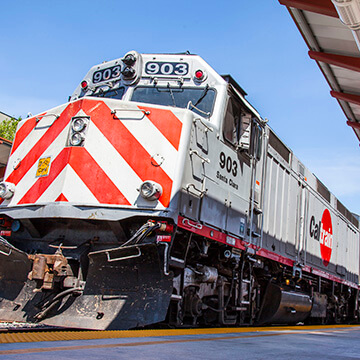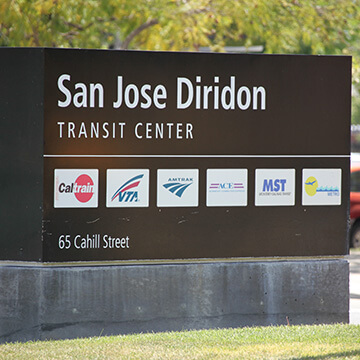High-Speed Rail at a Glance
Northern California
California is building a high-speed rail system to connect the megaregions of the state and transform how people travel. More than $1.6 billion of Proposition 1A funds and other California High-Speed Rail Authority funding are supporting investments in Northern California, including $714 million to Caltrain’s Peninsula Corridor Electrification Project.
HIGH-SPEED RAIL WILL provide clean, modern transportation for the millions of Northern California residents and will help tie the state’s economies together like never before. In Northern California, the system will have stations in San Francisco, Millbrae, San José, and Gilroy that will connect with BART, Caltrain, Amtrak, ACE and other regional rail and transit options.
Addressing the Issues
Curbing Air Traffic Congestion [1]
- The busiest domestic route in the nation is between SFO and LAX
- 1 in 5 flights out of the Bay Area is headed to the Los Angeles Area
- High-speed rail is the least expensive, most practical, and by far the greenest way to increase transportation capacity in California
Traffic [2]
- San Francisco drivers averaged 97 hours sitting in traffic during peak hours in 2019
- Traffic jams cost drivers $1,436 and the City of San Francisco $3 billion in 2019
- High-speed rail systems are fast and efficient, meaning you can reliably know when you’ll get to your destination
Access to More Affordable Housing [3]
- The average home price in the San Francisco Bay Area is now more than $1,300,000
- The average home price in the Central Valley is approximately $445,000
- High-speed rail can allow Silicon Valley to continue to flourish by relieving some of the housing pressure by reducing travel times to the Central Valley
Sections & Stations
The Authority is moving forward with the environmental documents for the San Francisco to San Jose project section and the San Jose to Merced project section. To view additional resources related to these documents, visit meethsrnorcal.org.
Explore below for details on high-speed rail project sections and current station planning and development in Northern California. The Authority continues to work with local partners to develop station area plans based around proposed high‑speed rail centers.
PROJECT PROGRESS
Get The Facts
Myth: California high-speed rail is a “train to nowhere” and will never come to the Bay Area.

Fact:
We are advancing every mile of the Phase I system from San Francisco to Los Angeles/Anaheim, and both Northern California project sections were environmentally cleared in 2022.
Myth: We don’t need high-speed rail when we can fly or drive from Northern California to Southern California.

Fact:
High-speed rail is the least expensive, most practical, and by far the greenest way to meet the need for increased transportation capacity in our state. Zero-emission high-speed rail trains, powered by 100% renewable energy, are a vital alternative to airplane and automobile travel.
Myth: Construction is only happening in the Central Valley.

Fact:
The Authority continues to invest in projects in Northern California that will provide near-term regional mobility benefits and lay the foundation for high-speed rail service. In collaboration with regional stakeholders, funding agreements have been completed for the following projects:
- $714 million for construction for the Caltrain Peninsula Corridor Electrification Project;
- $84 million for the San Mateo 25th Avenue Grade Separation Project.
Myth: The high-speed rail project has only created jobs in the Central Valley.

Fact:
To date, more than 730 small businesses, almost exclusively from California, have been bolstered by the high-speed rail project. 256 of those small businesses are located in Northern California.
In the Bay Area alone, the project has already generated 6,400 job-years of employment, $620 million in labor income, and $1.4B in economic output.
Want More Information?
Find more information about high-speed rail in California. From factsheets and regional newsletters, to maps and outreach events, get on board with the most up‑to‑date program information.
The California High-Speed Rail Authority makes every effort to ensure the website and its contents meet mandated ADA requirements as per the California State mandated Web Content Accessibility Guidelines 2.0 Level AA standard. If you are looking for a particular document not located on the California High-Speed Rail Authority website, you may make a request for the document under the Public Records Act through the Public Records Act page. If you have any questions about the website or its contents, please contact the Authority at info@hsr.ca.gov.










